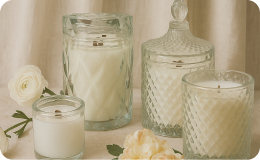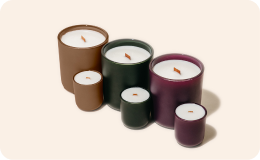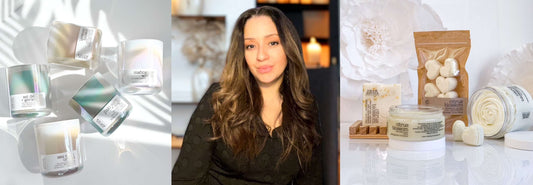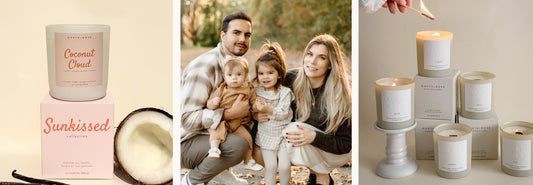Top Candle Making Terms
common candle making terminology
Whether you’re a seasoned candle maker or new to the industry, it’s important to stay in-the-know on candle vocabulary. Much like the industries of fashion, decor, and organized sports, candle making has its own language. This language is one that will help you and your candle making business succeed in the industry and ultimately, help you become the best Maker you can be!
Below are a few great reasons for why candle making terminology is important to know:
As with learning any language, some of these terms can be quite confusing. Terms like afterglow, tart, mushrooming, and frosting are common terms that you will become accustomed to recognizing and there are many more.
get to know common candle making terms
To make it easy for you, we’ve compiled a comprehensive glossary of terms for everything you need to know to master the art of candle making.
afterglow
the light emitted from the wick after the candle is put out.
booster wick
Also known as an Adhered Wick, The Original Booster Wick is an Original Wick in various sizes and thicknesses combined with a 3/16″/4.8mm Original Wick “booster” adhered vertically down the center of the wick. The Original Booster Wick is an ideal option for vegetable wax blends, beeswax candles, or candles with heavy fragrance or dye loads.
burn cycle
Nnot to be confused with Burn Rate or Burn Time, burn cycle is burning a candle for four hours, blowing it out, letting it cool, and then most likely repeating. This process is mainly used for evaluating wick performance as well as general candle testing.
burn rate
The amount of wax consumed per hour in grams. Burn rates will vary based on vessel size, wax type, and the heat emitted from your wick. A good rule of thumb to follow is small candles with small wicks can burn for seven to nine hours per 1 ounce of wax while those with large wicks burn approximately five to seven hours per 1 ounce of wax.
burn test
Also known as Test Burn, a specific, controlled, structured burn generally used to determine proper wick size. This is step 4 in the candle making process and one of the most important steps. After wax, vessel sizes, and fragrances have been chosen, it’s important to conduct a burn test to evaluate the best wick size and type for your specific candle. See our full blog post for more on burn testing.
burn time
The total amount of time it takes for a candle to burn to completion. Different factors will contribute to different burn time such as wax type, wick size, and vessel size.
carbon build up
Also known as mushrooming, the ball of carbon build-up on a wick. This is most common with cotton wicks but not as much with Wooden Wicks. To prevent build up on Wooden Wicks be sure to trim the wick and clear any carbon buildup between burns.
cold throw
The amount of fragrance emitted from a candle that is not burning. This is unique to each candle maker’s preference. Certain waxes have a better cold throw than others. For example, 100% Soy Wax has a reputation for not having a very powerful cold throw.
color
A visual description of the appearance.
congealing point
The temperature where the wax stops flowing as a liquid and sets up.
drop melt point
A "melt point"of this wax. In reality the wax blend is made up of several melt points and not well defined, but "Drop Melt Point" gives us a temperature reference of when the wax goes from solid to liquid.
dual wick
The original dual wick is part of our adhered wicks collection. It is 2 wicks of the same thickness adhered together using a proprietary non-toxic adhesive. In our burn testing, they risk becoming clogged with oiler waxes such as soy wax.
finishing
(With a heat gun): this is when a heat gun is applied to the top of the wax to smooth out any sinkholes or imperfections in the candle after the original setting.
flash point
The temperature at which a fragrance can ignite when exposed to a spark or flame. This can can be found on the fragrance safety data sheet or MSDS. See MSDS for more information.
fragrance load
Fragrance load (also known as scent load): the percentage of fragrance concentration in one batch of candles. We recommend using 8-10% fragrance per batch of candles. We have created a fragrance percentage chart to help you calculate your desired percentage load.
frosting
(Also known as "bloom"): the formation of white crystals on the surface of natural waxes (soy) caused by cooling at a different rate. This is not ideal with candle making as it can ruin the aesthetic of the candle. To help eliminate frosting, try heating your vessels and adjusting pour temperatures.
glass adhesion
(Also known as Wet Spots, Pull Away and Delamination): areas where the wax pulls away from the glass caused by inaccurate pouring temperatures or rapid ambient cooling. This is most common with soy and paraffin waxes.
gutter
Excess melted wax that can run down the outside of a pillar candle.
hang up
Remnant wax that remains on the wall of container candles when the candle has finished burning. This happens as a result of tunneling and can be prevented by making sure that your candle is achieving a full melt pool.
hot throw
(Also known as "Warm Throw" and "Scent Throw"): similar to cold throw, the fragrance emitted from a candle when it is burning. This is unique to each candle maker’s preference. Various wax types will give better hot throw. 100% Soy Wax has a reputation of poor hot throw and you may need to increase fragrance load up tp 12% for desired scent throw.
jump lines
(Also known as "Chatter" and "Stuttering"): the unintended horizontal lines or rings around the sides of either a container or pillar candle.
lovibond color
Scale is a color scale mostly used for liquids. It measures the redness and yellowness of the sample as a liquid. This spec is less useful from wax applications. It's most commonly used for liquids but can be measured for wax when it's melted as a liquid.
melt point
The temperature at which the wax begins to liquify. There are different melt points for each wax type so be sure to accurately follow the instructions of your chosen wax.
melt pool
The liquid pool of wax of a candle while burning. As a rule of thumb, you should expect a full melt pool to be achieved within 2-3 hours of burn time. An ideal melt pool at 4 hours is ½” in depth.
mix temperature
The recommended temperature of the wax when you add your fragrance and color. Each wax is different and fragrance should be accurately mixed at the corresponding required temperature. See WAX for more information.
mottling
The “snowflake” type appearance of the wax in the finished candle (pillars).
msds (material safety data sheets)
The product safety information sheets supplied by the manufacturers of your materials (wax, fragrance, colorants, additives, etc). These are important to reference for questions regarding flash point, melting instructions, and application information regarding the product’s ingredients and materials.
mushrooming
The carbon build up on the top of the candle wick (both after and while it is burning). Also see Carbon Buildup.
out of bottle
The first experience of a fragrance once the bottle is opened. This is referred to as out of bottle or OOB evaluation.
penetration
Gives you a value for the hardness of the wax. The higher the needle penetration number the softer the wax is. The lower the number, the harder the wax is.
pour temperature
The required temperature for pouring the fragranced and or colored wax into the vessel or mold. This is different for every wax type so be sure to follow the instructions for your specific wax.
power burn
Burning a candle for longer than 4 hours. This is often categorized as 8+ hours. This is dangerous and we do not recommend it.
relief holes
Holes that are manually poked into a candle as it cools to release air pockets that can form. Relief holes are used to eliminate sinkholes in conjunction with a heat gun. See "Heat Gun" for more information.
single ply wood wick
Made from a single piece of wood in varying thicknesses. They are currently available in .02, .03, and .04 thicknesses.
sink holes
Holes, craters, or actual cavities in the wax caused by air pockets trapped in a finished candle. This is fairly uncommon but most common with soy candles. They can be prevented by accurately following instructions for melting and pouring temperatures and ensuring that candles are setting on a flat, undisturbed surface. They can be fixed using relief holes and finishing with a heat gun. See Heat Gun for more information.
sweating
(Also known as "leaching"): the fragrance separating from the wax (often collecting on the top of a container candle in small beads or even a small pool). This is fairly uncommon but is often caused by rapidly moving a candle from one temperature to another. Soy wax is most sensitive to extreme temperature changes. Read more on our blog post What is Candle Sweating?
tart
(Also known as "Wax Melts"): scented waxes with no wick that are melted for fragrance in a “warmer." These are different than candles and can be created using soft waxes and high quality fragrances. They are often used for aromatherapy purposes.
transition temperature
The temperature or temperature range where a wax cooling from liquid state to solid state is changed from non-crystalline form to crystalline.
top pour
(Also known as "Re-Pour" and "Second Pour"): an additional pour after the candle has set to either fill in a sink-hole or smooth out the top.
tube wood wick
Provide a gorgeous circular shaped flame and work well in all wax blends. They are created to be used alone, but may be used with cotton wicks or wooden strip. Alone, a Tube Wick will create a 2 1/2″/63.5mm melt pool. For larger diameter containers, we suggest using multiple wicks evenly spaced apart. Tube Wicks are only available in a 6″/152.4mm length, so to achieve the optimal height, cut the wick to your specific length with a pair of scissors.
tunneling
When the wick is too small for the diameter of the candle and a full melt pool cannot be reached, a “tunnel” is formed. A wax wall will be left around the perimeter of the candle.
vessels
Also known as the jar or container that your candle is created in. They can be made from varying materials and can be found in different shapes and sizes.
viscosity
Of the wax is taken at 212F. IT gives you a value of how viscous the material is at 212F. High viscosity values indicate a "thick" liquid material, low values indicate a "thin" aqueous material.
wax
The filler substance that a candle is made from. The most common types are Paraffin, Beeswax, Soy, Coconut, and Vegetable Blend. We’ve created two natural premium wax blends, our Virgin Coconut Creme and Coco Apricot Creme waxes. Learn more about these wax types on our blog - Choosing the Best Candle Wax.
whisper wood wick
Whisper wooden wicks make approximately 50% less sound and creates a unique, teardrop shaped flame. They are made from a light-colored wood and are available as Single-Ply, Booster, or Dual.
wick down
(Also known as Size Down): during testing when you need to try one wick size smaller to try for optimal results. With wooden wicks, it could mean to go down one size in thickness or width or both.
wick up
(Also known as "Size Up"): during testing when you need to try one wick size larger to try for optimal results. With wooden wicks, it could mean going up a size in thickness or width or possibly both. It could also mean adding a booster strip.
wooden wick
A single-ply, multi-layered, curved, and decorative-shaped wick made from 100% wood, semi-wood, fibrous material, or cotton and wood combinations. All of our wooden wicks are naturally processed and sourced from Forest Stewardship Council (FSC) certified mills and manufactured with pride (and great skill) in the USA. To find the best wicks for your candle, reference our Wick Selection Guide.
Want to start experimenting with Wooden Wicks? Purchase a Sample Kit and begin conducting your burn tests today!









